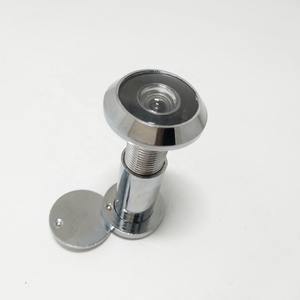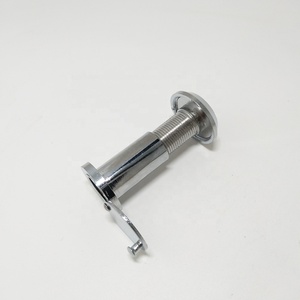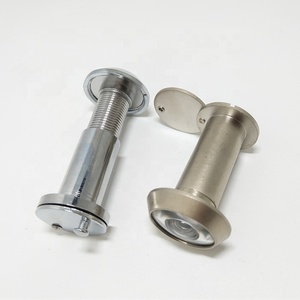(335 products available)











































































































































































































A peeping hole, also known as a door peephole or door viewer, is a small optical device that allows individuals to see who is outside their door without opening it. Here are some common types:
Standard Peephole
This basic kind is mostly installed on front doors and enables a clear view of anyone standing directly in front of the door. It usually has a 180-degree field of vision.
Wide-angle Peephole
This type is ideal for doors with narrow frames. It provides a broader view, sometimes up to 200 degrees, allowing the homeowner to see more of the entryway and part of the pathway.
Security Peephole
Designed for high-security locations, these peepholes are usually made of reinforced glass or metal. They provide an extremely clear image and are more resistant to tampering.
Illuminated Peephole
This peephole has a built-in light that turns on when the door is opened, making it easier to see in low-light conditions or at night. The illumination feature is beneficial for those in darker areas.
Magnifying Peephole
This type of peephole incorporates a magnifying lens that makes it easier to see details of the person standing outside. It is beneficial for those who may have trouble seeing clearly.
Digital Peephole
This modern upgrade replaces a traditional optical device with an electronic one. It usually consists of a camera mounted on the outside of the door and a digital display screen on the inside. Some advanced versions may include features such as motion sensors, night vision, and the capability to store images or video footage. Digital peepholes often provide a more comprehensive view and higher image quality. They may also be equipped with additional features like a timer to record the time of events or a built-in alarm system. This kind of peephole can be powered by batteries or connected directly to the electrical wiring of the door.
Smart Peephole
Smart peepholes are the most advanced and incorporate technology to connect with smartphones, tablets, or home security systems. They often come with high-definition cameras, motion detection, and night vision capabilities. Some models allow two-way audio communication, enabling conversations with visitors without opening the door. Notifications will be sent directly to the connected devices when someone is at the door, even if the homeowner is not at home. Many smart peepholes also have the capability to take pictures or record videos of visitors. They can be easily installed and integrated into existing smart home setups, providing enhanced security and convenience.
The functions of the peep holes include:
The features of a peep hole include:
The peeping hole has various applications. Here are some common usage scenarios:
Door Security
The primary use of a peeping hole is for security purposes. It is installed on doors, allowing homeowners to see who is outside without opening the door. This feature enables them to identify visitors, delivery personnel, or potential intruders before deciding to open the door. It is an important security feature for any door.
Home Surveillance
Peeping holes can also complement home surveillance systems. They provide an additional layer of security by allowing residents to visually confirm any unusual activity captured by surveillance cameras. This helps in quick decision-making in case of potential threats.
Office Privacy
In office environments, peeping holes are used for privacy and security. They are installed on conference room doors to enable people inside to see visitors before opening the door. This ensures privacy during confidential meetings and security in high-stakes discussions.
Monitoring
Peeping holes are used in various industries to monitor specific areas without direct access. For instance, in laboratories, peeping holes allow scientists to observe experiments in controlled environments without interrupting the process. In animal shelters, staff use peeping holes to check on animals in kennels without entering the space.
Emergency Services
Emergency responders use peeping holes to assess situations before entering potentially dangerous environments. For example, firefighters and police officers use peeping holes to identify people inside and observe the scene in hostage situations or armed attacks.
Historical Architecture
Peeping holes are used in historical and architectural contexts to create visual connections between spaces. They are incorporated in walls, doors, and windows to allow light and views to pass through. This feature is used in modern architecture to enhance design elements and improve natural light.
Animal Observation
Peeping holes are also used in animal care facilities and zoos to observe animals without disturbing them. Staff and visitors use these holes to see animals in their enclosures, ensuring their safety and reducing stress caused by direct interaction.
Assess the Door Material and Thickness:
The material and thickness of the front door can greatly influence the kind of peep hole for door choice. Certain kinds of door viewers are specifically designed for doors that are thick or made of certain materials. When selecting a door viewer, it is important to first measure the thickness of the door and take into account the material it is made of. This will ensure a perfect fit and installation.
Consider the Viewing Angle and Distance:
It is important to consider the angle of view and distance of the peeping hole. A wider angle will allow a more comprehensive view of the area outside the door. On the other hand, some viewers have a restricted field of view. Also, the distance from where the viewer stands should be considered. Those who stand closer to the door may find a more focused view better. In contrast, those who stand further away may benefit from an extended lens.
Examine the Lens Quality:
The clarity and durability of the images obtained through the peeping hole are determined by the quality of the lens. For sharp and clear images, select models with high-quality glass lenses rather than those with standard plastic lenses. Good lens quality offers better visibility and improves the overall value of the safety measures.
Assess the Privacy Features:
It is important to check the privacy characteristics of the peep hole before making any purchase. Certain models include features that ensure the privacy of the owner, like rotating or retractable lenses that can be used to block the view from outside. Select a model that meets the requirements for privacy and security.
Installation Requirements:
It is important to check the installation procedures before purchasing any peeping hole. Some models can be installed easily without the need for special tools or skills. On the other hand, others may need professional installation because of complicated procedures. Consider the required level of convenience and expertise before settling on a particular model.
Q1. What is the purpose of a peephole?
A1. Peepholes allow people to see who is at their door without opening it. This provides security by letting the homeowner view visitors first.
Q2. What is a keyhole called?
A2. A keyhole can be referred to as a ""peep hole"" or ""key hole"" in English. It is the hole in the door where the key is inserted to lock or unlock it.
Q3. What is the meaning of peephole?
A3. A peephole is an opening or hole that is used for looking at something with the aim of seeing what is going on without being seen. It is commonly used to refer to a small hole in a door that is intended for someone to look through and see who is standing outside without having to open the door.
Q4. What are the different types of peepholes?
A4. There are various types of peepholes, including traditional glass lens peepholes, wide-angle peepholes, digital electronic peepholes, and smart video doorbell peepholes.
Q5. What is the difference between a peephole and a keyhole?
A5. A keyhole is specifically designed for inserting a key to lock or unlock doors, while a peephole is intended for visually observing through a small opening.